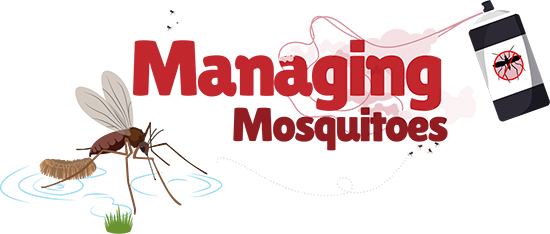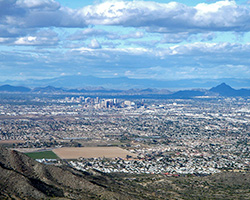
Illustrated by: Megan Joyce
An Introduction to Mosquitoes

You’ve been playing outside for most of the day, with no issue. But as it starts to get later in the day, you hear that annoying high-pitched buzzing very close to your ear. It’s a mosquito. You swat it away, but you think about going inside to avoid being bitten. While mosquitoes may only be an annoyance to some, for many people around the world, mosquitoes are dangerous. In this lesson, you will learn about mosquitoes, what habitats they like, how to avoid being bitten, and how to help keep their numbers in check.
You will do this while also discussing ways to communicate information to others. You will learn about mosquito life cycles and diseases with your class, do a potentially life-saving and room-rearranging activity, and create a "public service announcement" video with your classmates to share what you've learned with others.
What You Need
- Slide presentation (your teacher has this)
- Pre-lesson & post-lesson quizzes
- Computer
- Internet access
- Butcher paper or tarps
- Pencils or pens
- Storyboard template
- Technology to record a 2 - 3 min video (phone/tablet/Zoom/etc.)
Procedure
Before You Begin
The very first thing you should do is answer all the questions on the pre-lesson quiz. This one has PRE written in the top corner. Don't worry, this first one is not for points! When you've completed the quiz, make sure your name is on it and turn it into your teacher.
ENGAGE: Mosquito Habitats

1. Look closely at the first two pictures in the slide presentation. What do you think the mosquito populations would be like in the Everglades in Florida, versus in the Petrified Forest in Arizona. Think about (or discuss with your classmates) why these places might be so different in the size of their mosquito populations.

2. After you and your class have finished talking about the habitats and how they affect mosquito populations, take a look at the next picture, an aerial view of Phoenix, Arizona. Phoenix, Arizona is a desert landscape, but it still has desert rivers and streams, and people have brought water into the urban areas. Based on your ideas or discussion from Step 1, what do you think the mosquito population might be like here? And finally, look at the picture of a cactus in the snow. How do you think seasons affect mosquito populations?
EXPLORE: Water Collection
3. Start the water collection activity. Imagine you are looking out the back door of a home where you are staying, at a large backyard. A heavy rain is falling, lightning flashes, and thunder claps, shaking the room around you. Soon, the storm will pass, leaving the sweet smell of wet ground behind.

Some water collection can be good, and can help you store water to clean for drinking, or to deeply water crops and other plants well after it rains. But if water sits uncovered for just a couple days, it can become a breeding ground for mosquitos. Those buckets, or even just small trays left outside, can gather enough water for female mosquitoes to lay their eggs. If you don’t find those water stores and dry them out, soon you will have more mosquitos than normal, and a higher risk for disease.
Now, in a minute, you are going to get up quietly and pretend that the room you are in now is that backyard. There’s no ceiling above you, and rain has filled anything that will hold it. Quietly, you will walk around, and take notes on places where water might collect. When you’re done, sit back down. You have two minutes. Go.
4. Make a list of the spots in the room where water might be stored if it started raining inside. If you are doing this with a class or study group, share with your peers where you think water might collect. Make a complete list of places you and your classmates found.
5. Optional: Now you will "fix" these water collection locations. If in a class, get into small groups of 2 to 3 students. Modify these spots so they are not an issue any longer. There are some rules to this! For anything heavy or larger than a bucket, do not move it. Instead, you can pretend pieces of butcher paper are tarps, and use them to cover anything you can’t safely turn on its side. You could use a small object as a pretend mosquito "dunk" (a bacterial treatment for the water) to put into reservoirs that can’t be overturned or altered.
EXPLAIN

6. If you are in a class, discuss the activity you've completed. How did you treat different types of objects and why did you make those decisions? If you aren't working with a group, take notes on the decisions that you made and why.
7. Listen and learn as the teacher presents about mosquito life cycles, the diseases mosquitoes can carry, and more. If you are working by yourself, look through the presentation and read the accompanying notes.
8. Discuss or take notes on what new information you learned about mosquitoes from the presentation. Do you have any questions about mosquitoes or how to avoid being bitten? If so, note them down to look up later, or discuss as a class.
9. Complete the mosquito worksheet. If in a class, go over the answers as a group. If working alone, you can go back to the presentation to check your answers.
ELABORATE

10. You are going to create a Public Service Announcement ("PSA"). The goal of this activity is to create a PSA video on how people can protect themselves against mosquitoes and their bites. You can focus on how to control mosquito larvae, how to protect against adult mosquitoes, options to deter mosquitoes with or without chemicals, or discuss a different approach. If in a class, you will work in groups of 2-3 students.
11. Watch a few example PSA videos (links to a few examples are at the end of the slide presentation). Discuss as a class what steps might go into making a PSA video and complete the list below. (The eight steps below are not required and you can add more if needed.)
- Brainstorm subject ideas
- Select one idea
- Do research
12. Following the steps you've outlined, make a plan for your PSA. Whenever you've completed your prep work, flim and edit the video and turn it in or, if you like, post it somewhere.
EVALUATE
13. Using some of the knowledge you've gained throughout the lesson, you will create a story or a long poem about mosquitoes on your own. This written piece should include at the very least 3 pieces of information about mosquitoes that you think is important. Try to be creative; you could describe some part of a mosquito's life, write about mosquito-borne diseases, or write a poem about what you imagine a mosquito might be thinking. The 3 mosquito facts should be clearly presented, even if the written piece is poetry. These pieces should be between 100 and 300 words long. Once you've completed the paragraph or poem, write an additional 2-3 sentences about what (if anything) you learned from this lesson that you hadn't already known.
14. Answer the questions in the post-lesson quiz. This one has POST in the top corner.
About the Authors: Karla Moeller is an Executive Educational Outreach Coordinator and a children’s book author, David Roman is an educational technologist and is earning a GIS certificate, and Silvie Huijben is an Assistant Professor of Evolutionary Biology; the authors created this activity at Arizona State University.
Mosquito pupae image by the CDC. Additional images via Wikimedia Commons.
Read more about: Managing Mosquitoes
Bibliographic details:
- Article: Managing Mosquitoes
- Author(s): Karla Moeller, David Roman, Silvie Huijben
- Publisher: Arizona State University School of Life Sciences Ask A Biologist
- Site name: ASU - Ask A Biologist
- Date published:
- Date accessed:
- Link: https://askabiologist.asu.edu/experiments/managing-mosquitoes
APA Style
Karla Moeller, David Roman, Silvie Huijben. (). Managing Mosquitoes. ASU - Ask A Biologist. Retrieved from https://askabiologist.asu.edu/experiments/managing-mosquitoes
Chicago Manual of Style
Karla Moeller, David Roman, Silvie Huijben. "Managing Mosquitoes". ASU - Ask A Biologist. . https://askabiologist.asu.edu/experiments/managing-mosquitoes
Karla Moeller, David Roman, Silvie Huijben. "Managing Mosquitoes". ASU - Ask A Biologist. . ASU - Ask A Biologist, Web. https://askabiologist.asu.edu/experiments/managing-mosquitoes
MLA 2017 Style

Two Culex mosquito pupae, also known as "tumblers." How can we control mosquito population sizes at different stages of their lives?
Learn more about mosquito life stages, ecology, prevention, and what diseases they can carry in our story, All About Mosquitoes.
Make sure you have everything you need for this activity:
Be Part of
Ask A Biologist
By volunteering, or simply sending us feedback on the site. Scientists, teachers, writers, illustrators, and translators are all important to the program. If you are interested in helping with the website we have a Volunteers page to get the process started.
